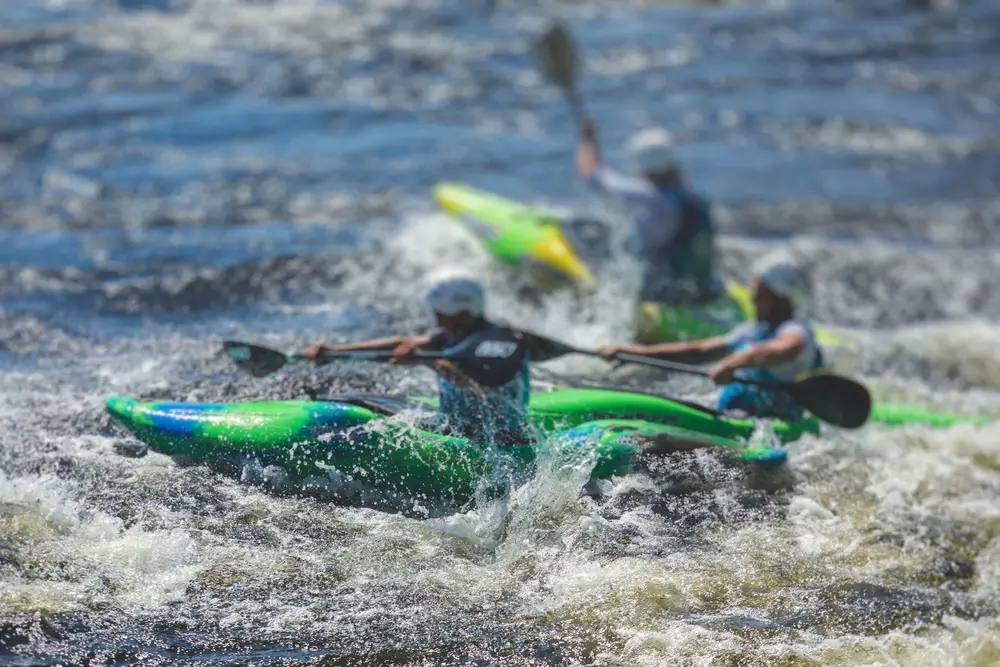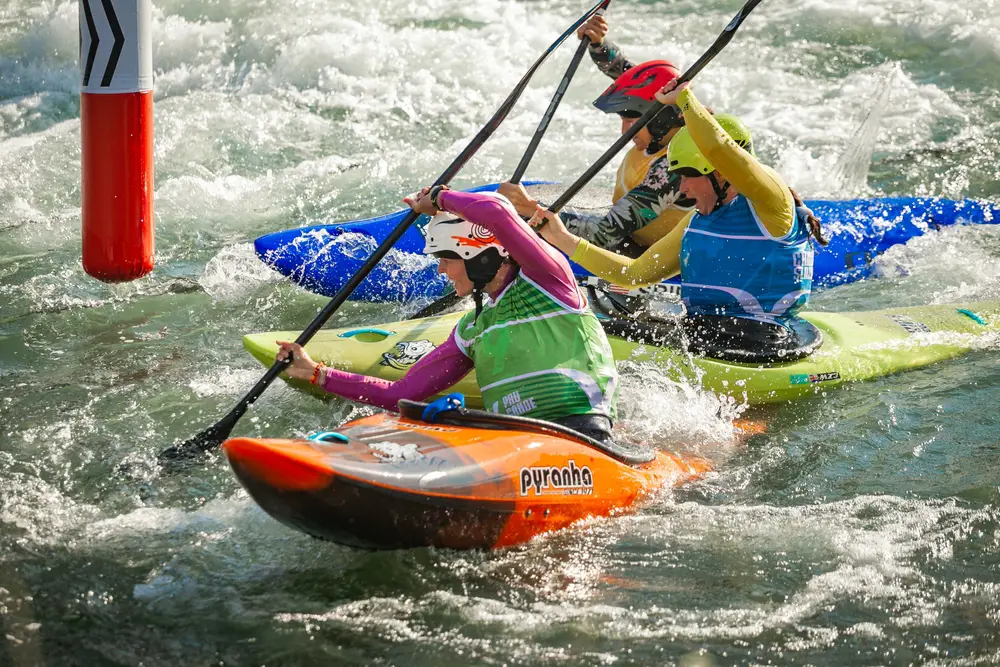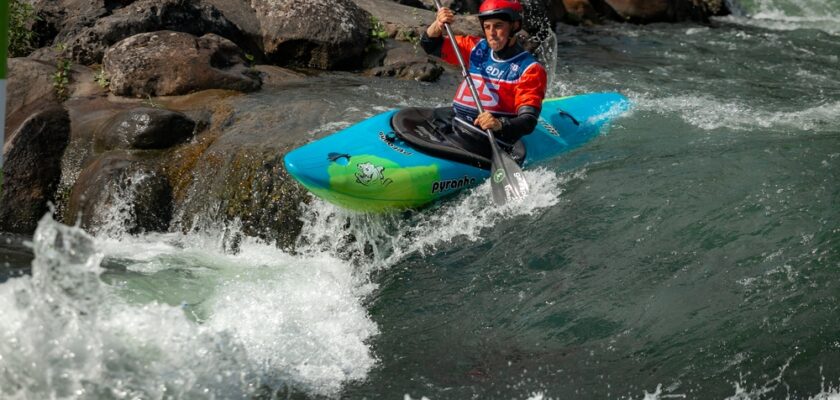Slalom canoeing is a water sport that requires a lot of skill, speed and precision from the athletes. Derived from alpine skiing, the sport involves rapid descents in turbulent waters, and athletes must navigate a course marked out by gates.
These gates are actually PVC rods that are suspended over the water. The aim of the sport is to complete the course in the shortest time possible. Slalom canoeing became an Olympic sport in 1972, at the Munich Games, and since then it has evolved in terms of regulations and technology.
That’s why it’s essential to know the rules of slalom canoeing, whether you’re a practitioner, an enthusiast or just a fan. Check out the article we’ve prepared with everything you need to know about the rules.
Check out the main rules of slalom canoeing!
Open your Betano account and get up to 1,000 reais in bonuses.
PIX payments, live games and super odds!
Click here to open your account!

Slalom canoeing rules: complete list
- Competition venue;
- Race duration;
- Scoring;
- Modes and equipment;
- Infractions and penalties;
- Security;
- Classification.
Slalom canoeing rules: competition venue
Slalom canoeing is practiced on a course that must be designed to challenge competitors, using both natural and artificial obstacles.
This course is usually between 250 and 400 meters long and must include a combination of fast water, drops and very sharp turns.
In addition, a certain number of gates must be present on the track. These gates, which are rods made of PVC, vary between 18 and 25 units, some of which must be navigated upstream and others against the current.
The gates are marked with green and white rods to indicate passage upstream, and red and white to indicate passage against the current.
Canoe slalom rules: race duration
The length of a canoe slalom race is not fixed and can vary greatly. This is because it depends on the time it takes each athlete to complete the course.
On average, the best race times vary between 90 and 120 seconds. However, there is a time limit set by the organizers, which is usually between 150 and 200 seconds. If an athlete exceeds this limit, they are automatically disqualified.
Slalom canoeing rules: scoring
Scoring in canoe slalom is based on the total time it takes the athlete to complete the course, counting penalties.
Each touch of a gate adds 2 seconds to the total time, and if the athlete fails to pass through a gate correctly, another 50 seconds are added.
The aim of the competition is to have the shortest total time, adding together the course time and the penalties. It’s important to note that penalties are cumulative in slalom canoeing and can easily turn a good course time into a poor result.
Slalom canoeing rules: modes and equipment
Each canoe slalom race can be individual or in pairs. In the individual races, C1 (single canoe) and K1 (single kayak) compete. In the double races, C2 (double canoe) is the discipline contested.
The boats must meet specific length and weight standards. While kayaks (K1) are around 3.5 meters long and weigh at least 9 kg, canoes (C1 and C2) are a little shorter, but follow strict minimum weight and size regulations.
Slalom canoeing rules: infractions and penalties
Check out the main infractions and penalties according to the canoe slalom rules:
- Touching the door: when an athlete touches any part of a door with their body, paddle or boat, they receive 2 seconds added to their total time.
- Failure to pass a door: if an athlete does not pass correctly, does not pass completely through the door or passes the door in the wrong direction, they are penalized with 50 seconds added to the total time.
- Failure to complete the course: if an athlete does not complete the designated course or does not navigate all the gates, they are disqualified from the race.
- Intentionally avoiding a gate: the athlete cannot intentionally avoid a gate to gain a time advantage. If they do, they will be disqualified from the race.
- Use of unregulated equipment: the use of boats or equipment that do not conform to the technical specifications required by the competition rules will result in disqualification from the race.
- Receiving external assistance: if an athlete receives any form of external assistance during the race, except in emergency situations, they will be disqualified from the competition.
- Unsportsmanlike behavior: any behavior considered unsportsmanlike, including disrespecting officials, other competitors or the public, can result in penalties such as a warning or disqualification, depending on the severity.
- Leaving before the signal: when an athlete leaves before the official race start signal, they may receive a time penalty or disqualification.
- Use of steroids or prohibited substances: any use of any prohibited substance, according to anti-doping regulations, ends in immediate disqualification.
- Lack of safety equipment: competing without the mandatory safety equipment, such as a life jacket and approved helmet, can result in the athlete being disqualified.
Slalom canoeing rules: safety
Safety is very important in slalom canoeing. All competitors are required to wear life jackets and helmets approved by the international federations.
In the sport, the courses are monitored by rescue teams who are always ready to intervene in the event of accidents. Boats must also be inspected constantly to ensure that they are in perfect condition, with no structural flaws that could compromise the athlete’s safety.
Slalom canoeing rules: classification
Canoe slalom competitions usually have several phases, including heats, semi-finals and finals. In the knockout stage, all competitors make at least two descents, and the best combined times advance to the semi-finals.
In the semi-final, each competitor makes one more descent, and the best advance to the final. And in the grand final, the times of the previous descents are not taken into account, with the winner being decided on the basis of the final descent.

Slalom canoeing rules: complete list
- Competition venue;
- Race duration;
- Scoring;
- Modes and equipment;
- Infractions and penalties;
- Security;
- Classification.
Slalom canoeing rules
This was our special article with the main rules of slalom canoeing. If you liked the content, take the opportunity to continue exploring the site to stay up to date on this and other sports, checking out lists, news, glossaries and other types of content. Your comments are also very welcome here!





